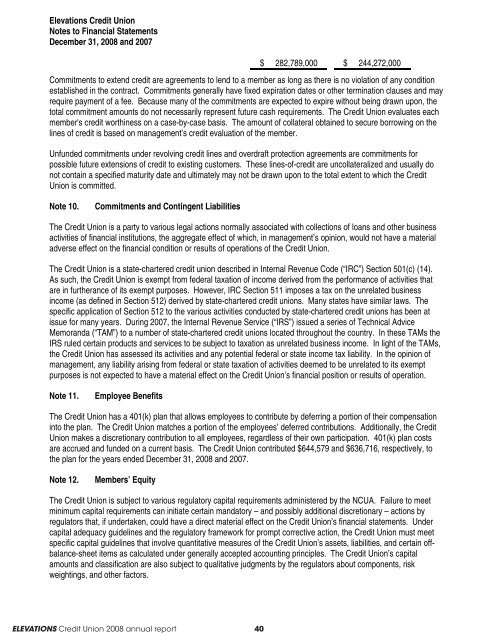7 6 5 4 3 2 1 8 - Elevations Credit Union
7 6 5 4 3 2 1 8 - Elevations Credit Union
7 6 5 4 3 2 1 8 - Elevations Credit Union
You also want an ePaper? Increase the reach of your titles
YUMPU automatically turns print PDFs into web optimized ePapers that Google loves.
<strong>Elevations</strong> <strong>Credit</strong> <strong>Union</strong><br />
Notes to Financial Statements<br />
December 31, 2008 and 2007<br />
ELEVATIONS <strong>Credit</strong> <strong>Union</strong> 2008 annual report 40<br />
$ 282,789,000 $ 244,272,000<br />
Commitments to extend credit are agreements to lend to a member as long as there is no violation of any condition<br />
established in the contract. Commitments generally have fixed expiration dates or other termination clauses and may<br />
require payment of a fee. Because many of the commitments are expected to expire without being drawn upon, the<br />
total commitment amounts do not necessarily represent future cash requirements. The <strong>Credit</strong> <strong>Union</strong> evaluates each<br />
member's credit worthiness on a case-by-case basis. The amount of collateral obtained to secure borrowing on the<br />
lines of credit is based on management’s credit evaluation of the member.<br />
Unfunded commitments under revolving credit lines and overdraft protection agreements are commitments for<br />
possible future extensions of credit to existing customers. These lines-of-credit are uncollateralized and usually do<br />
not contain a specified maturity date and ultimately may not be drawn upon to the total extent to which the <strong>Credit</strong><br />
<strong>Union</strong> is committed.<br />
Note 10. Commitments and Contingent Liabilities<br />
The <strong>Credit</strong> <strong>Union</strong> is a party to various legal actions normally associated with collections of loans and other business<br />
activities of financial institutions, the aggregate effect of which, in management’s opinion, would not have a material<br />
adverse effect on the financial condition or results of operations of the <strong>Credit</strong> <strong>Union</strong>.<br />
The <strong>Credit</strong> <strong>Union</strong> is a state-chartered credit union described in Internal Revenue Code (“IRC”) Section 501(c) (14).<br />
As such, the <strong>Credit</strong> <strong>Union</strong> is exempt from federal taxation of income derived from the performance of activities that<br />
are in furtherance of its exempt purposes. However, IRC Section 511 imposes a tax on the unrelated business<br />
income (as defined in Section 512) derived by state-chartered credit unions. Many states have similar laws. The<br />
specific application of Section 512 to the various activities conducted by state-chartered credit unions has been at<br />
issue for many years. During 2007, the Internal Revenue Service (“IRS”) issued a series of Technical Advice<br />
Memoranda (“TAM”) to a number of state-chartered credit unions located throughout the country. In these TAMs the<br />
IRS ruled certain products and services to be subject to taxation as unrelated business income. In light of the TAMs,<br />
the <strong>Credit</strong> <strong>Union</strong> has assessed its activities and any potential federal or state income tax liability. In the opinion of<br />
management, any liability arising from federal or state taxation of activities deemed to be unrelated to its exempt<br />
purposes is not expected to have a material effect on the <strong>Credit</strong> <strong>Union</strong>’s financial position or results of operation.<br />
Note 11. Employee Benefits<br />
The <strong>Credit</strong> <strong>Union</strong> has a 401(k) plan that allows employees to contribute by deferring a portion of their compensation<br />
into the plan. The <strong>Credit</strong> <strong>Union</strong> matches a portion of the employees’ deferred contributions. Additionally, the <strong>Credit</strong><br />
<strong>Union</strong> makes a discretionary contribution to all employees, regardless of their own participation. 401(k) plan costs<br />
are accrued and funded on a current basis. The <strong>Credit</strong> <strong>Union</strong> contributed $644,579 and $636,716, respectively, to<br />
the plan for the years ended December 31, 2008 and 2007.<br />
Note 12. Members’ Equity<br />
The <strong>Credit</strong> <strong>Union</strong> is subject to various regulatory capital requirements administered by the NCUA. Failure to meet<br />
minimum capital requirements can initiate certain mandatory – and possibly additional discretionary – actions by<br />
regulators that, if undertaken, could have a direct material effect on the <strong>Credit</strong> <strong>Union</strong>’s financial statements. Under<br />
capital adequacy guidelines and the regulatory framework for prompt corrective action, the <strong>Credit</strong> <strong>Union</strong> must meet<br />
specific capital guidelines that involve quantitative measures of the <strong>Credit</strong> <strong>Union</strong>’s assets, liabilities, and certain offbalance-sheet<br />
items as calculated under generally accepted accounting principles. The <strong>Credit</strong> <strong>Union</strong>’s capital<br />
amounts and classification are also subject to qualitative judgments by the regulators about components, risk<br />
weightings, and other factors.


